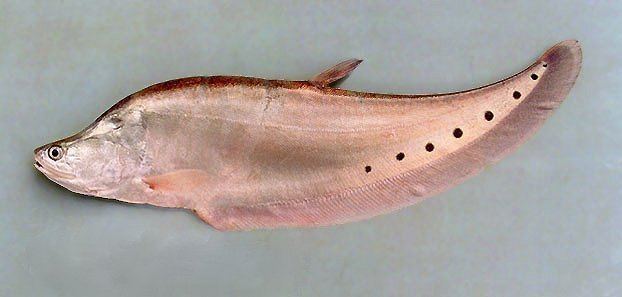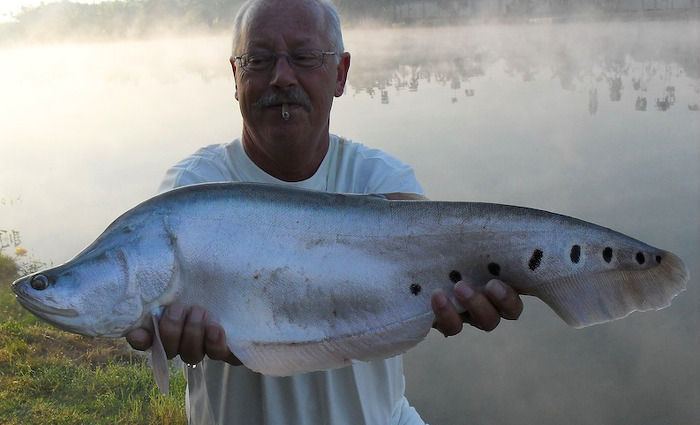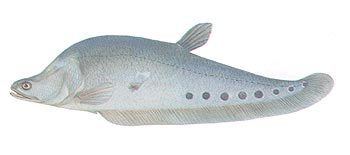Kingdom Animalia Order Osteoglossiformes Genus Chitala Rank Species | Phylum Chordata Family Notopteridae Scientific name Chitala ornata Higher classification Chitala | |
 | ||
Similar Chitala, Bronze featherback, Chitala chitala, Notopteridae, Royal knifefish | ||
Clown knife fish clown featherback
The clown featherback, clown knifefish, or spotted knifefish, Chitala ornata, is a nocturnal tropical fish with a long, knife-like body. This knifefish is native to freshwater habitats in Cambodia, Laos, Thailand and Vietnam, but it has also been introduced to regions outside its native range. It is one of world's most invasive species.
Contents
- Clown knife fish clown featherback
- Clown featherback feeding
- Distribution
- Appearance
- Behavior
- In the aquarium
- Feeding
- As food
- References

It is often seen in aquaculture and the aquarium trade where frequently confused with Chitala chitala; the latter species is very rare in the aquarium trade. Despite its popularity, the clown featherback reaches 1 m (3.3 ft) in length, outgrowing all but the largest aquaria.

Clown featherback feeding
Distribution

This species is native to Cambodia, Laos, Thailand and Vietnam, where found in the Mekong, Chao Phraya and Meklong river basins. It has also been introduced to regions outside its native range, including the Philippines, Myanmar, Singapore, Sri Lanka, and Palm Beach County, Florida, United States.
Appearance

The clown knifefish is very distinct, with normally silvery gray with a long knife-like body (laterally compressed) and a long anal fin that gives these fish their common name. Mature fish normally have five to ten (or even more) black spots ringed with white that usually decrease in size as the fish grows. These ocellated spots and the lack of faint stripes on the back separate it from Chitala chitala; a species it frequently has been confused with. Albinos and leucistic specimens are seen with some frequency in the aquarium trade.

Juveniles lack the spots, but are overall striped. Their long anal fins are used to make graceful forward and backward movements.
The clown knifefish grows to a fairly large size, up to 1 m (3.3 ft) and 5 kg (11 lb) in the wild. It has two nasal tentacles above its large, toothed mouth. In the center of the body is a flaglike dorsal fin and has no ventral fins. Most clown knifefish are afflicted with cloudy eye color when they age.
Behavior
They are nocturnal and usually cruise during the twilight hours. They normally hunt live prey and will try any fish that fits into their mouths. Young clown knifefish usually school near water logs and plants for security, whereas more mature specimens usually become territorial and eventually become loners. These fish can also breath air to survive in stagnant waters and little oxygen. The clown knifefish prefers water around neutral pH and temperature ranging from 75 to 85 °F (24 to 29 °C). These fish usually are found in lakes, swamps, and river backwaters.
In the aquarium
Clown knifefish are sold as exotic fishes in pet stores, but they grow much too large for the average home aquarium. These fish have periods of retreat, so aquaria which have caves, plants, or other hiding places are preferred. They are jumpers, so the lid should be kept tightly closed. Dim lighting may help lessen jumping. For the first few days, clown knifefish are shy and prone to hiding. As they grow larger they tend to be quite the opposite.
Feeding
Clown knifefish are hearty eaters, and will take live foods such as feeder fish, ghost shrimp, and blackworms. With time, they can be adapted to foods such as beefheart and will sometimes learn to accept commercial food pellets. They are mostly nocturnal, thus prefer feeding when the lights are off.
As food
The clown featherback is commonly seen in the cuisine of Thailand and other southeast Asian countries. In Thailand when deep-fried as Pla krai thot krathiam (ปลากรายทอดกระเทียม) it is served with a spicy dipping sauce on the side made by mashing up coriander roots, bird's eye chillies and garlic, and mixing this with fish sauce, lime juice and sugar. The clown featherback is also the main fish used in the production of fish balls.
